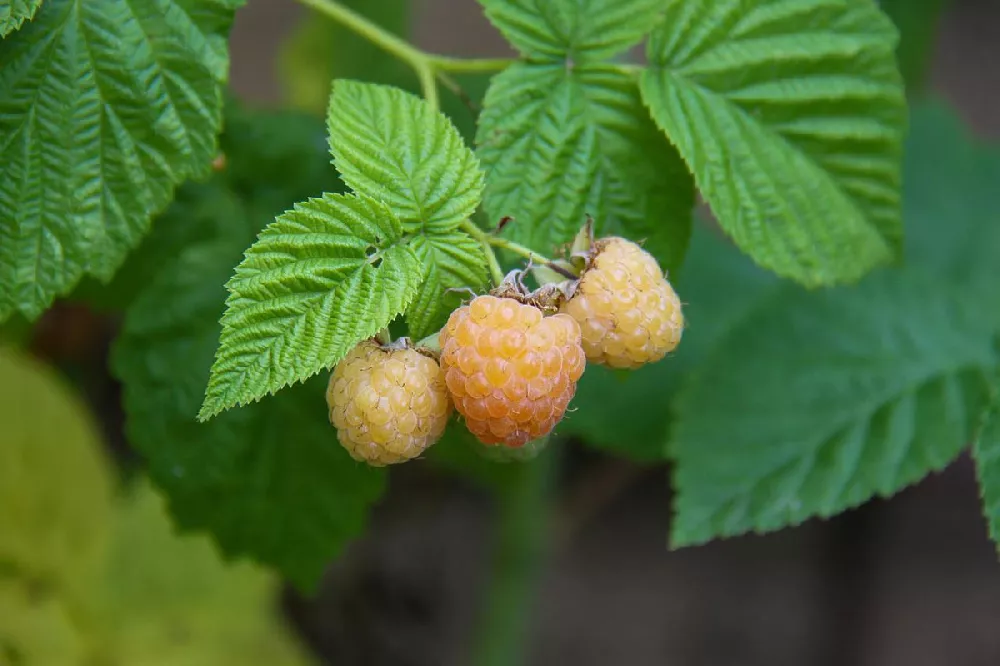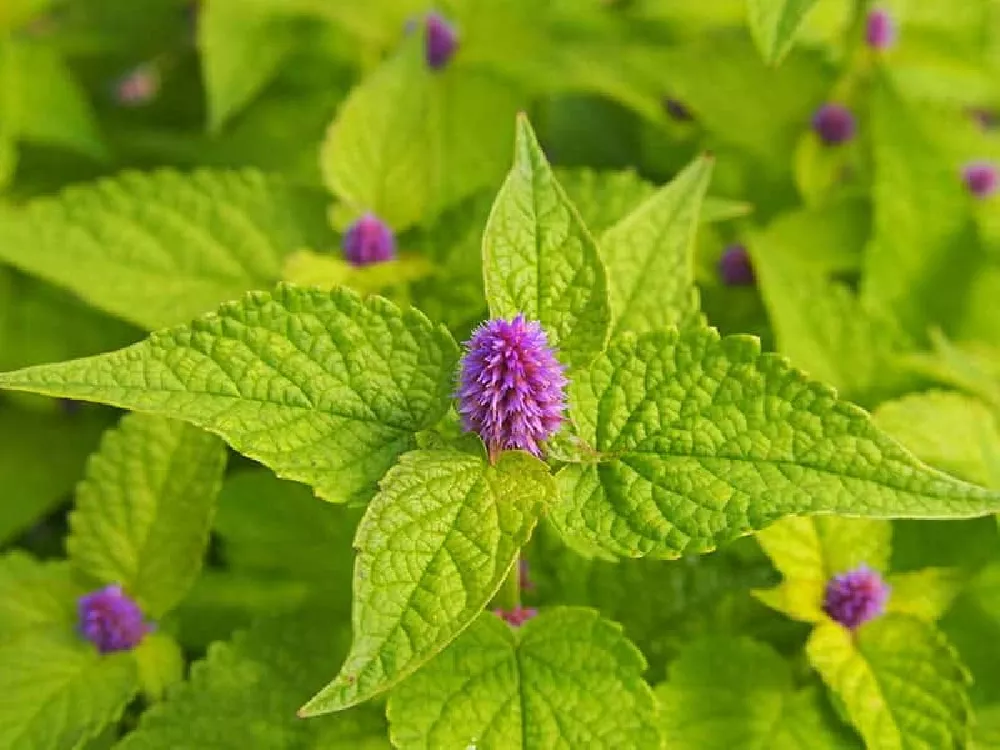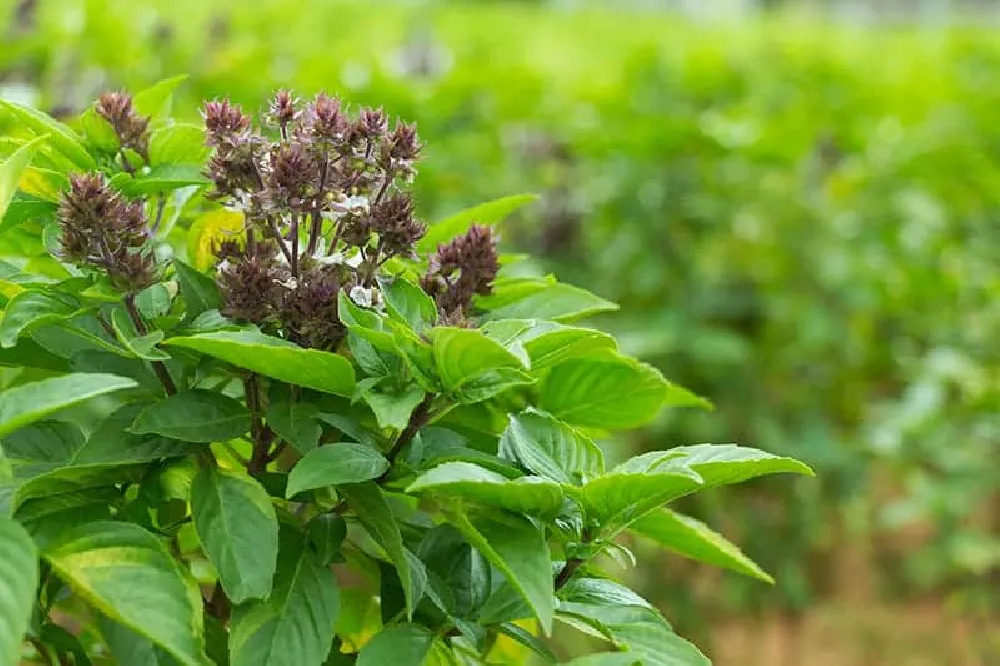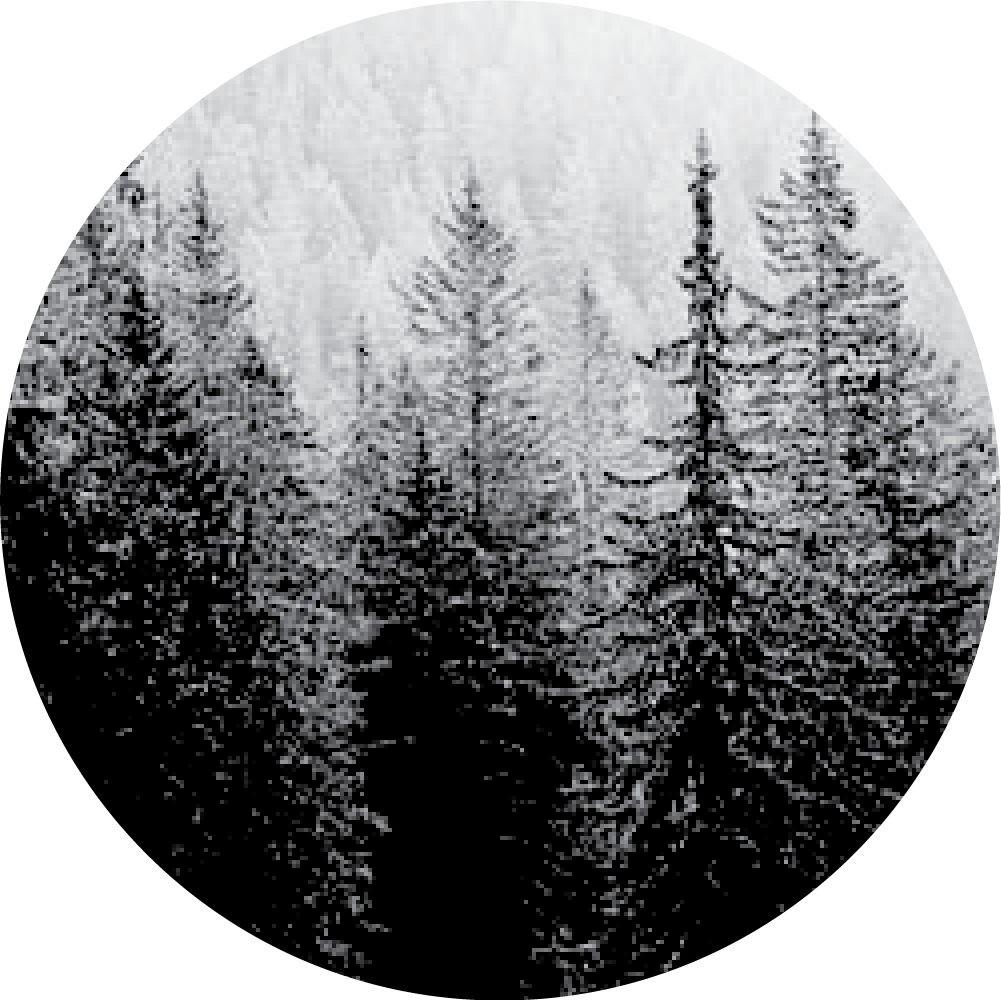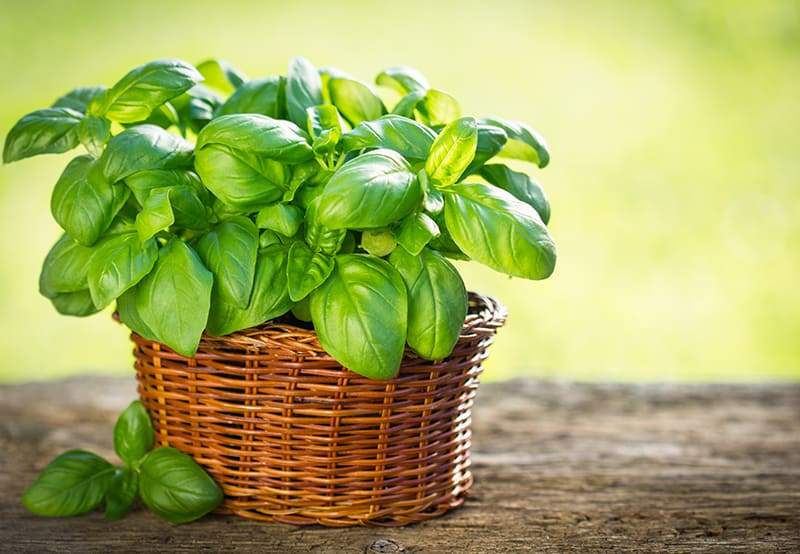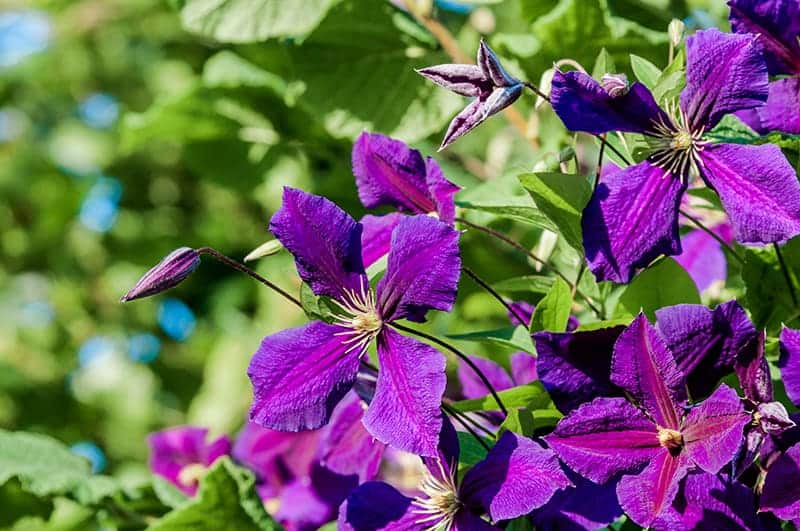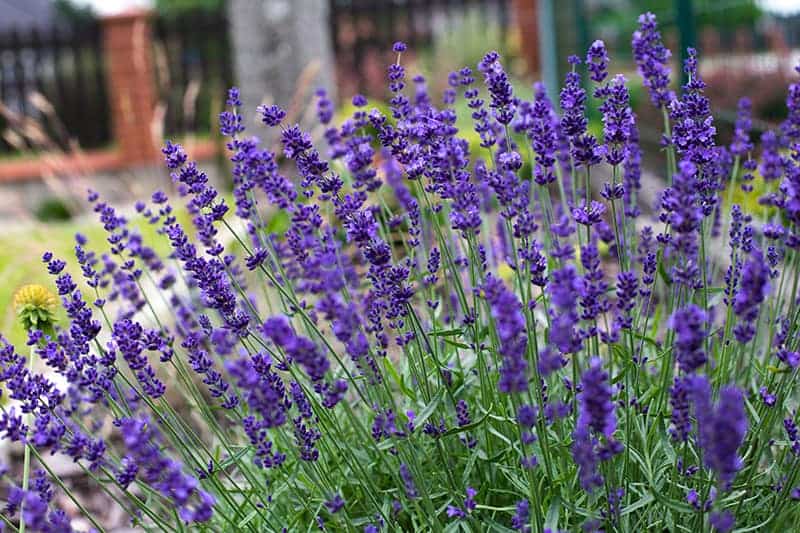- Home >
- Herb Plants >
- Sage Plants
Sage Plants for Sale - Buying & Growing Guide
Filters
Price Range
Growing Zones
Plant Type
Sunlight
Mature Height
Plant Characteristics
3 Results
Sage Plants – Buying & Growing Guide
Sage plants encompass a plethora of plants that can be woody shrubs or tender herbs. Many are perennial in warm climates, but they are also popularly cultivated as annuals in cooler regions. Some sage plants are edible and commonly used for culinary purposes, while other sage plants are purely ornamental. Learn about the different types of sage plants here.
1. Common Garden Sage
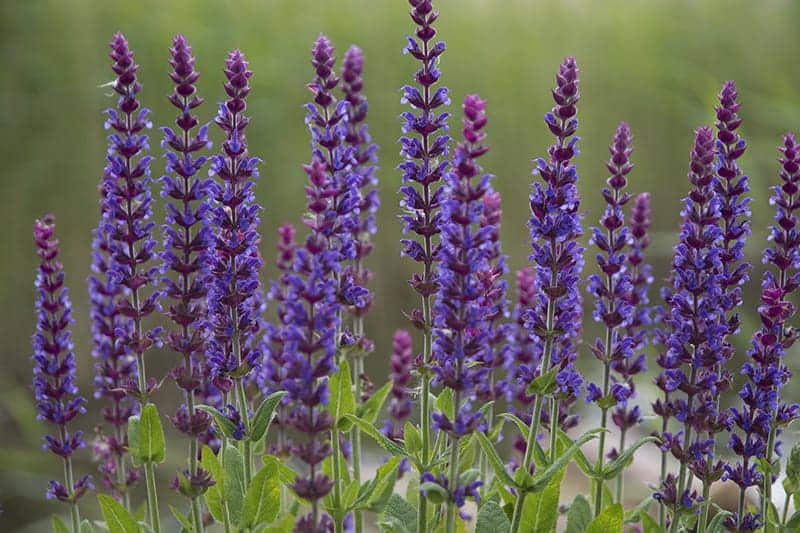
Scientific Name: Salvia officinalis
Mature Size: Up to 2 feet tall
USDA Hardiness Zone: 4-10
Light: Full sun
Water: Average moisture needs
Soil: Well-draining
Flower Color: Red and purple
Cultivars and Varieties: Salvia officinalis’ Tricolor’ (Tricolor Sage), Salvia officinalis’ Icterina’ (Golden Sage), Salvia officinalis ‘Purpurascens’ (Purple Sage)
This is the type of sage that is commonly grown for culinary uses. Its leaves can be used fresh or dried in cooking or brewed to make tea. This is a perennial dwarf shrub that is semi-evergreen. It grows to form clumps that grow as wide as they are tall. It produces gray-green foliage that is deeply aromatic and lavender blooms on flower spikes. This plant grows best in full sun though it will tolerate some dappled shade. It is drought-tolerant but will perform best in a light, moist soil. These plants tend to become very woody after three or four years and will be unable to produce aromatic leaves. You will need to replace the plant at this stage if you want to use the leaves as herbs.
2. Scarlet Sage
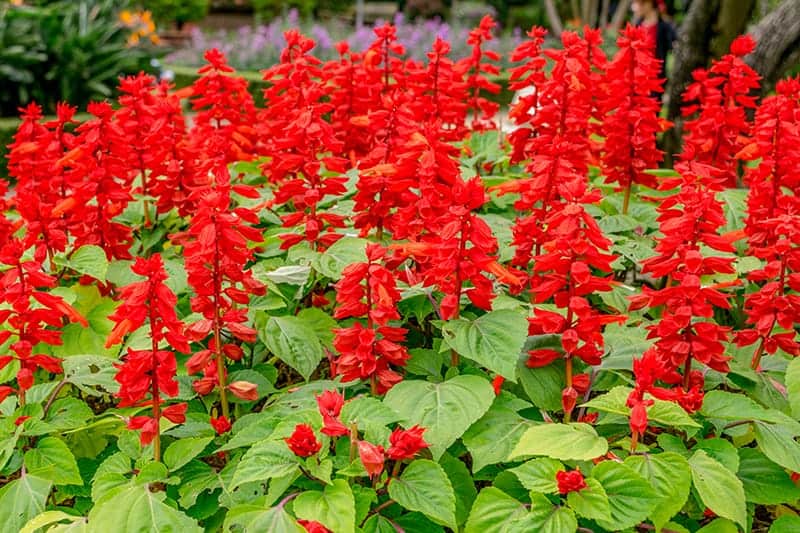
Scientific Name: Salvia splendens
Mature Size: Up to 2 feet tall
USDA Hardiness Zone: 2-11
Light: Full sun
Water: Maintain moist soil
Soil: Well-draining, sandy, fertile
Flower Color: Red, pink, white, blue, orange, purple
Cultivars and Varieties: Salvia splendens’ Saucy Red’, Salvia splendens’ Saucy Wine’
This is a tender perennial that will grow year-round in zones 10 and 11 but is also commonly grown as an annual in cooler regions. As you might expect from the common name, it is famed for its brilliant bright red flowers; however, newer cultivars have been bred that also come in shades of purple, pink, white, blue, and orange. The flowers are borne on tall spikes that sit above the green foliage. Each flower is tube-shaped, with a long blooming period. These make excellent cut flowers and can be planted in beds, borders, or containers.
3. Annual Sage
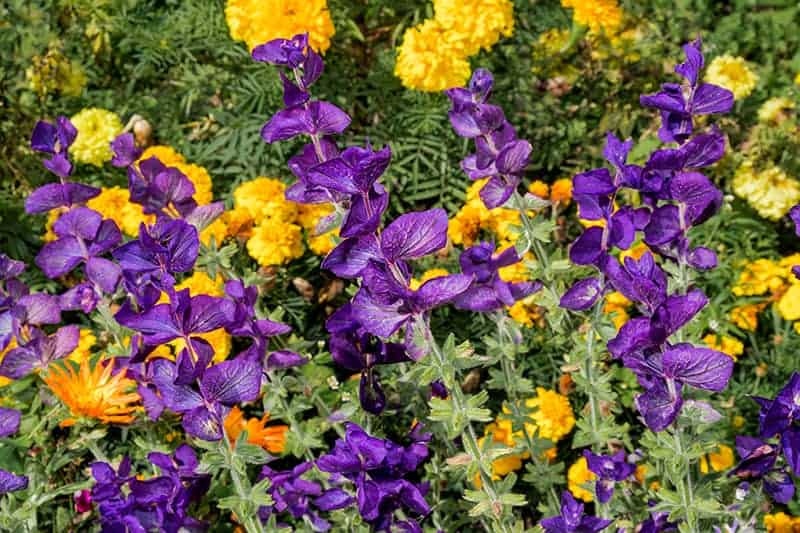
Scientific Name: Salvia horminum
Mature Size: Up to 2 feet tall
USDA Hardiness Zone: 3-11
Light: Full sun to partial shade
Water: Average moisture needs
Soil: Well-draining, rich
Flower Color: Blue, pink
Cultivars and Varieties: Salvia horminum’ Blue’, Salvia horminum’ Blue Monday’, Salvia horminum’ Pink Sunday’
This vigorous annual grows in clumps of around one foot wide. It is densely branched, with showy flowers blooming in abundance from summer right through to fall. The flowers bloom on chunky erect stems, providing an abundance of color amongst the mid-green foliage. These plants can be grown from seed, and are very easy to grow and care for. They require little maintenance, including deadheading spent flowers to encourage re-blooming. The long-lasting flowers make good fresh cut bouquets, but they can also be dried and used for decorative purposes.
4. Mealy Cup Sage
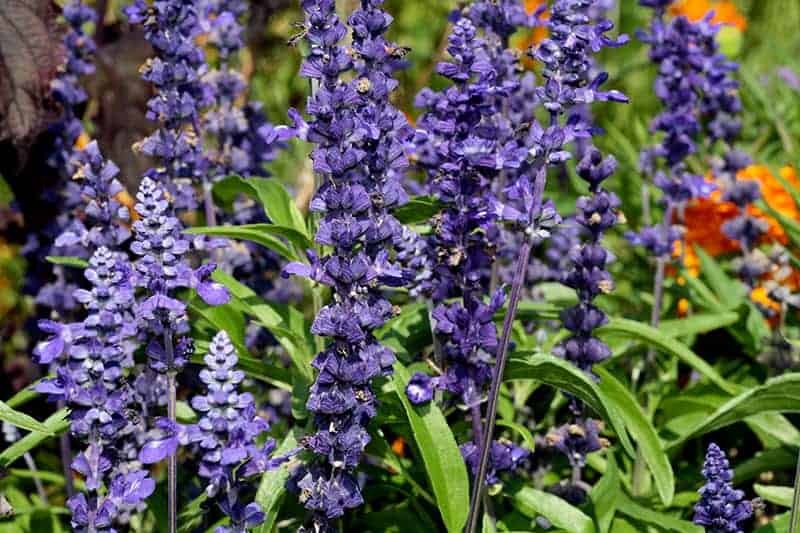
Scientific Name: Salvia farinacea
Mature Size: Up to 3 feet tall
USDA Hardiness Zone: 8-10
Light: Full sun
Water: Maintain moist soil
Soil: Well-draining, rich
Flower Color: Blue and purple
Cultivars and Varieties: Salvia farinacea’ Victoria Blue’, Salvia farinacea ‘Fairy Queen’, Salvia farinacea ‘Blue Bedder’
This evergreen plant is a prolific bloomer, flowering from spring right through to the first frost. It produces tall flower spikes that are densely packed with intensely saturated blooms in various shades of blue. The foliage is slender and gray-green, creating an attractive shrubby base for the flower spikes to sit above. This plant brings a lovely vertical element to beds and borders and is also commonly used as a cut flower. It can also be used as an annual plant in cooler regions, below USDA hardiness zone 8. It is enormously attractive to butterflies and other pollinators. It will grow best in soils that are kept consistently moist; however, once established, it can tolerate drought.
5. Cleveland Sage
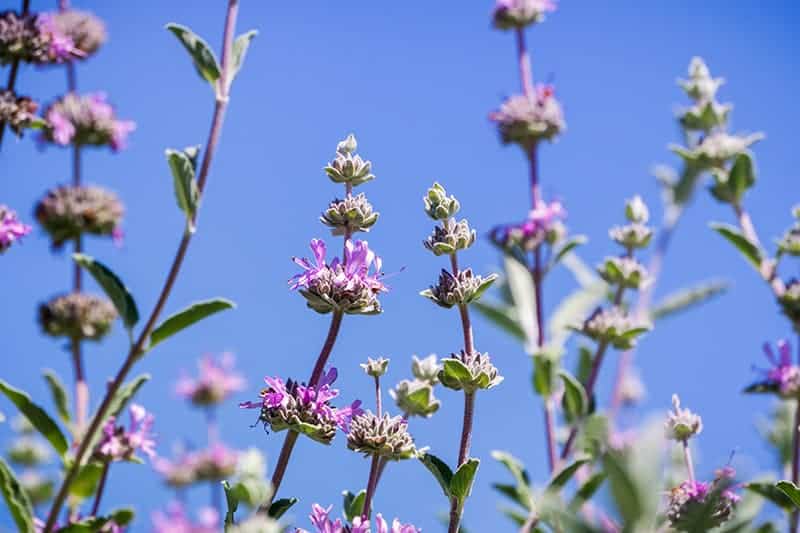
Scientific Name: Salvia clevelandii
Mature Size: Up to 5 feet tall
USDA Hardiness Zone: 9-11
Light: Full sun to partial shade
Water: Low water needs
Soil: Well-draining
Flower Color: Purple
This sage is native to California, where it grows year-round as a perennial plant. It is a medium-sized shrub, growing to a width of up to eight feet and a height of five feet. It has a rounded, bushy habit, densely packed with lance-shaped leaves that measure around two inches long. Foliage is gray-green in color, with a slightly rough texture. They are aromatic and edible and are often used in cooking instead of common garden sage. From the middle of spring to the end of summer, the plant sends out long, arching stems, covered with clusters of tube-shaped lavender colored flowers. This plant loves hot and dry climates and is drought-tolerant. In fact, it prefers dry soils and should not be watered once established-it will survive purely on rainfall.
6. Pitcher Sage
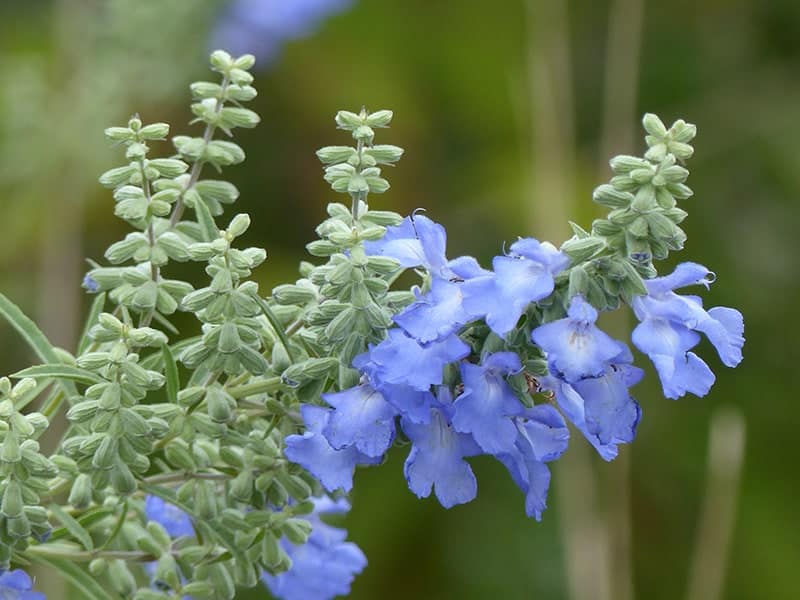
Scientific Name: Salvia azurea
Mature Size: Up to 5 feet tall
USDA Hardiness Zone: 5-9
Light: Full sun
Water: Low moisture needs
Soil: Well-draining, gritty
Flower Color: Blue
This perennial shrub is native to the Southeastern United States. It grows in clumps, being slightly taller than it is wide. The foliage of this plant is narrow and slender, with a gray-green coloring. It produces spikes of heavily flowering blooms from midsummer through to the first frost. At first, these stems are erect, but they begin to arch and sprawl under the weight of their flowers. Flowers are true blue, with two petals on each bloom. They thrive in sandy or gritty well-draining soils, which are kept dry. These plants are drought-tolerant and prefer dry soil.
7. Autumn Sage
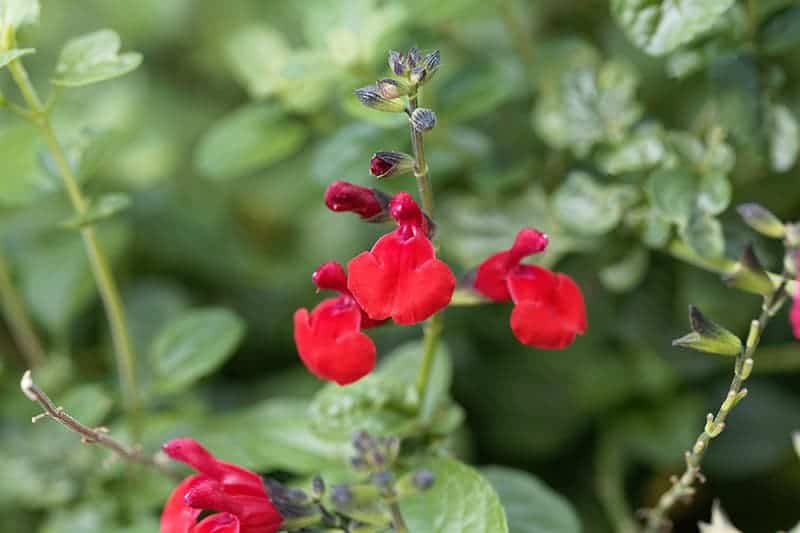
Scientific Name: Salvia greggii
Mature Size: Up to 3 feet tall
USDA Hardiness Zone: 6-9
Light: Full sun
Water: Low moisture needs
Soil: Well-draining, fertile
Flower Color: Red, pink, purple, yellow
This small shrub is native to Texas and Mexico, where it remains evergreen all year round. It will also grow in cooler climates but will be deciduous in these cases. It produces velvety green leaves that are ovate and measure around two inches long. Foliage is aromatic, with a scent reminiscent of mint. The plant blooms heavily from spring right through to fall, with tall racemes of flowers that can be red, purple, yellow, or pink. This plant works well in beds and borders, and can also be used to create a low hedge. It is tolerant of heat, humidity, and drought, and thrives in a well-draining, moderately fertile soil.
8. Anise-Scented Sage
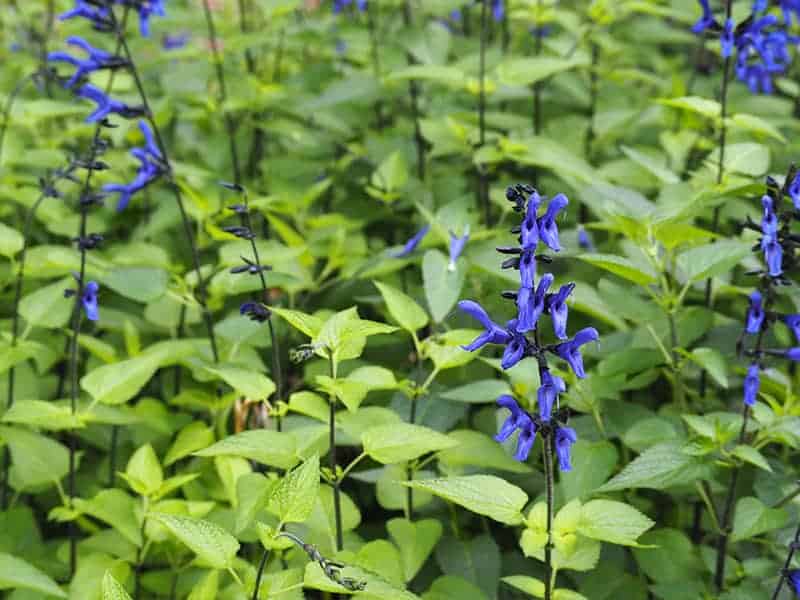
Scientific Name: Salvia guaranitica
Mature Size: Up to 5 feet tall
USDA Hardiness Zone: 7-10
Light: Full sun to partial shade
Water: Maintain moist soil
Soil: Well-draining, organically rich
Flower Color: Blue
Cultivars and Varieties: Salvia guaranitica’ Black and Blue’, Salvia guaranitica ‘Black and Bloom’
This perennial plant is evergreen in warm winter climates, between USDA hardiness zones seven to ten. In cooler regions, it can be grown as an annual. As the name suggests, it produces aromatic leaves that have a scent similar to anise. The plant features clumps of green, ovate leaves, and in mid-summer will send out tall, erect stems, from that blue flowers bloom. The flowers measure around two inches long, and they are a tubular shape with a wide-open mouth at their tip. They stay in bloom until the first frost. This plant thrives in full sun, and it can tolerate some shade, but too much shade will cause the plant to become droopy. Deadhead spent blooms to encourage further blooming, then cut back the plant after flowering has finished.
9. Mexican Bush Sage
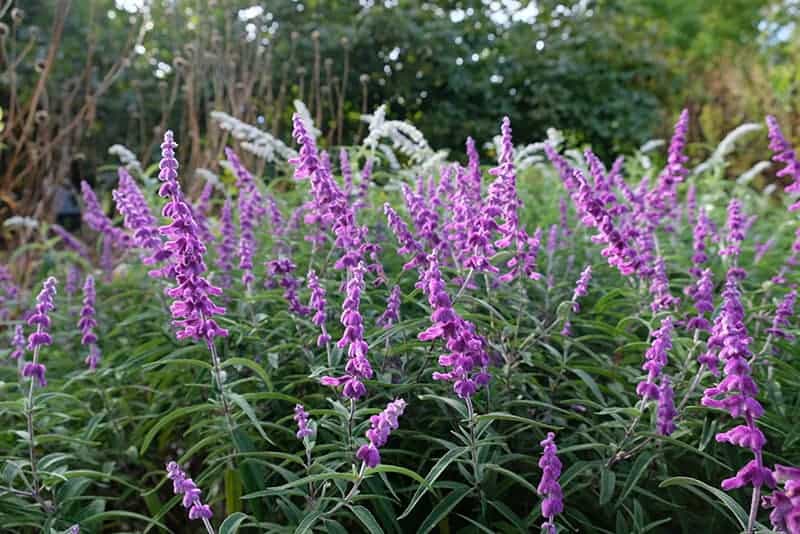
Scientific Name: Salvia leucantha
Mature Size: Up to 6 feet tall
USDA Hardiness Zone: 8-10
Light: Full sun to partial shade
Water: Maintain moist soil
Soil: Well-drained, rich
Flower Color: Purple
This evergreen perennial takes the shape of a medium to large shrub, growing between four and six feet tall, with a similar-sized spread. It has attractive deep green-gray leaves, which are lance-shaped. But the flowers of this plant are its best feature, arriving on long spikes that are covered with purple and white, velvety soft blooms. The flowers have a long blooming period from mid-summer through to the first frost. The plant grows easily, preferring a position of full sun, though it will tolerate light shade. It is drought-tolerant once established but will perform best when moist soil is maintained. This plant has won the Award of Garden Merit from the Royal Horticultural Society.
10. Woodland Sage
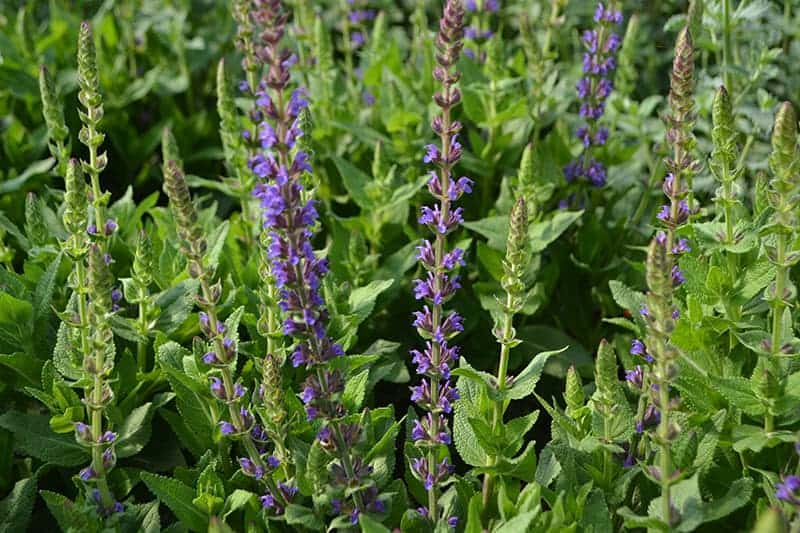
Scientific Name: Salvia nemorosa
Mature Size: Up to 2 feet tall
USDA Hardiness Zone: 3-9
Light: Full sun
Water: Maintain moist soil
Soil: Well-draining, gritty
Flower Color: Purple, blue, pink
Cultivars and Varieties: Salvia nemorosa’ New Dimension Blue’, Salvia nemorosa’ Crystal Blue’, Salvia nemorosa’ Bumbleberry’
Woodland sage is a perennial plant that grows in compact clumps of up to two feet tall, though often, it will not exceed one foot in height. The foliage is an attractive shade of gray-green and has an aromatic scent. The flowers of this plant appear on tall, erect, slender stems. The spikes are covered with small flowers in various shades of blue and purple depending on the variety; some are a pale purple-pink, some are a deep purple-blue, and there are several in between. They usually bloom in late spring or the beginning of summer and stay in flower for several weeks. This plant thrives in full sun in well-draining soil. Amend heavy soil with sand or gravel to create a more gritty texture to help these plants succeed. They grow easily and require very little maintenance.
11. Pineapple Sage
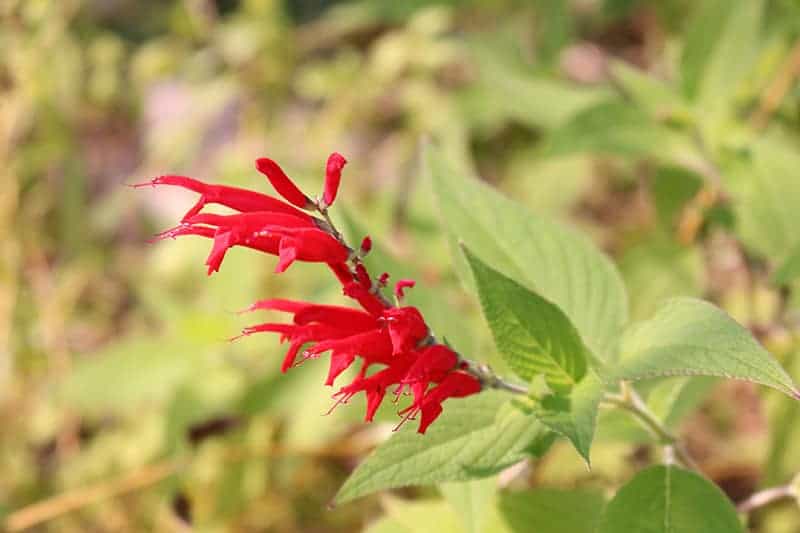
Scientific Name: Salvia elegans
Mature Size: Up to 4 feet tall
USDA Hardiness Zone: 8-11
Light: Full sun to partial shade
Water: Maintain moist soil
Soil: Well-draining
Flower Color: Red
This plant is grown as a perennial in warm winter climates, and can also be grown as an annual in cooler climates. Although this is a type of sage, it’s leaves do not resemble typical sage leaves, and they are bright green and fresh looking. They are strongly scented with an aroma that is similar to pineapple, though taste-wise, they closely resemble mint. This is an edible plant, and the foliage can be used in cooking or brewed in teas to create a drink similar in taste to a mint tea. It is also a medicinal herb with antibacterial properties. This plant has a vigorous growth habit and thrives best in a position with the sun in the morning and shade in the afternoon. It is drought-tolerant once established, but it will perform best in a soil that is kept consistently moist.
12. Desert Sage
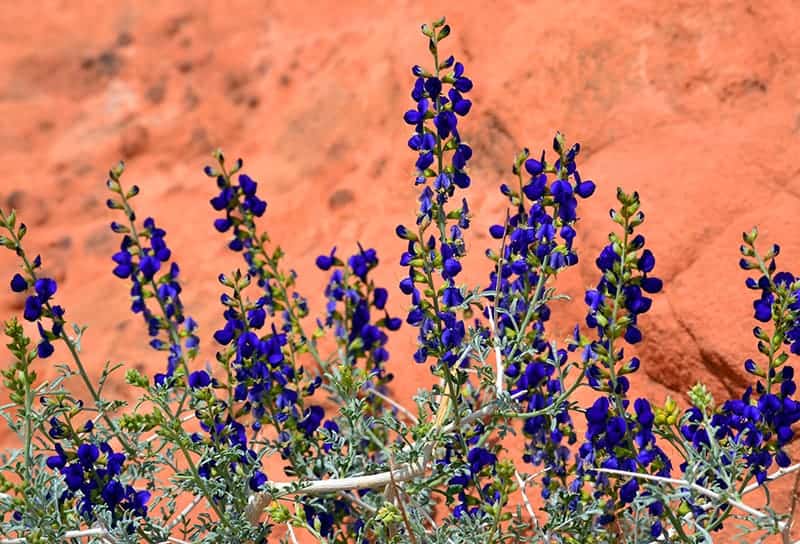
Scientific Name: Salvia dorrii
Mature Size: Up to 3 feet tall
USDA Hardiness Zone: 9-11
Light: Full sun
Water: Low moisture needs
Soil: Well-draining, sandy, poor to average
Flower Color: Purple
This perennial shrub is native to desert areas of the Western US, and as such, it requires hot and dry conditions. It grows to form rounded clumps of fragrant gray-green leaves. During the summer months, it can bloom several times, sending out tall, upright stems of bright purple flowers. They make excellent cut flowers, and can also be dried for floral arrangements. This plant thrives in poor soil, so long as it is well-draining. It will tolerate rocky and infertile soils and can struggle to survive in soils that are rich or fertile. The plant prefers a dry growing medium, and should not be watered often. It is drought-tolerant and thrives on neglect when kept in the right conditions.
